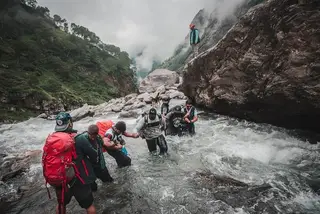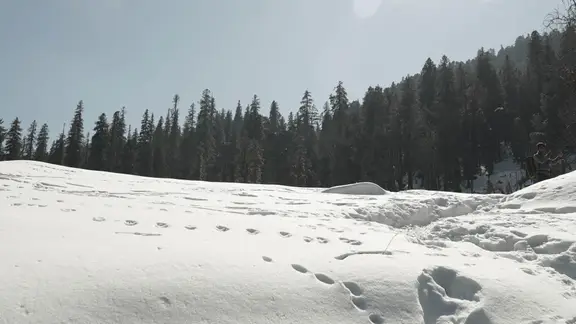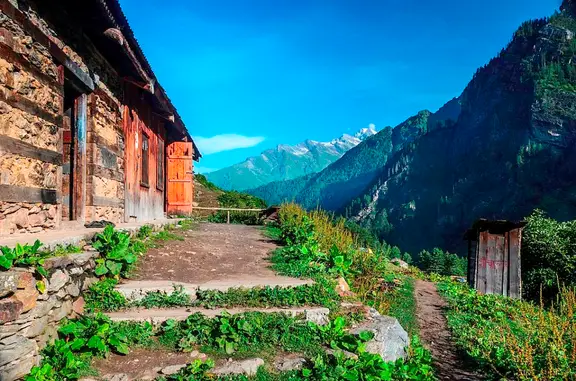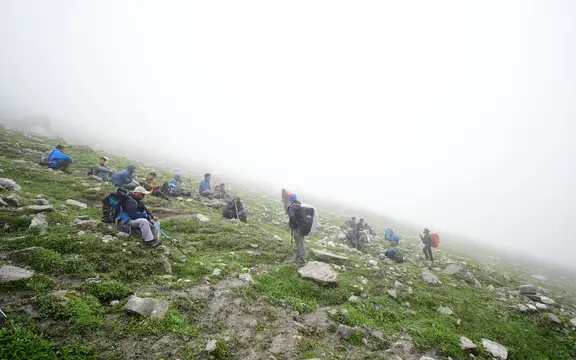Altitude Mountain Sickness
No description available.


Also known as Acute Mountain Sickness, it is one of the most common ailments that can afflict mountaineers, trekkers or anyone undertaking a vacation in the mountains. It results when one climbs to a higher elevation rapidly and the body doesn't get adequate time to adapt to low pressure and low oxygen levels.
High altitude 8000-12,000 feet above sea level Very high altitude 12,000-18,000 feet above sea level Extremely high altitude Above 18,000 feet
However, acute mountain sickness can even be experienced at an altitude as low as 6,500 feet.
Who are at risk- Anyone who climbs to a higher altitude too quickly without giving adequate time to body to adapt to lower air pressure and lower oxygen levels
- The more rapid a climb, the more likely one is at risk of developing AMS.
- Staying at a high altitude for too long can also cause AMS
- The more strenuous the climb that requires more energy, the more the likelihood of getting AMS
- People with lung or heart disease
- Pregnant women
- People who have had AMS in the past
- Chronic mountain sickness is considered to be genetic
- People who live in low altitude areas and are not adapted to living in higher altitudes might get AMS
Apart from this, anyone irrespective of their age and health can get it. In fact, higher physical activity at a high altitude makes you more susceptible to get AMS.
Symptoms of mild and short-term AMS
- Shortness of breath
- Nausea
- Fatigue
- Dizziness
- Loss of appetite
- Insomnia
- Lack of energy
- Fast heart rate
- General malaise
These symptoms usually start within 12-24 hours of arriving at a high altitude and last for a day till the person gets used to the higher elevation.
Symptoms of moderate AMS
Symptoms of moderate AMS are more severe and longer-lasting than mild AMS. The symptoms are not relieved by over-the-counter medicines.
Mild AMS and moderate AMS are characterized by the same symptoms except that all these symptoms worsen as the time progresses and show no signs of improvement. Tightness and congestion in the chest, lack of coordination, severe headache with hampered normal activities call fan immediate action.
Symptoms of severe AMS
Look out for following symptoms for severe AMS-
- The confused state of mind
- Fluid build-up in lungs and brain
- Inability to walk
- Shortness of breath even while at rest
- Insufficient urine production
Severe AMS is an emergency situation and needs immediate medical attention. The affected person should be taken to a place of lower altitude than 4000 feet immediately.
HAPE and HACE
High altitude pulmonary edema (HAPE) and high altitude cerebral edema (HACE) are the complications that usually arise above 12,000 feet. Both these complications arise when a person climbs a high altitude too rapidly and stays there for a long time.
HAPE causes fluid to build up in the lungs that prevents oxygen from getting into the bloodstream. With the progression of HAPE, the oxygen levels in the blood drop causing-
- Blue skin
- Difficulty in breathing
- Tightening in chest
- The confused state of mind
- Disorientation
- Fatigue
- Persistent cough with white or pink froth
If left untreated, HAPE can turn fatal. In HAPE, the person should immediately descend to an altitude lower than 4000 feet.
HACE usually occurs when a person stays at a high altitude for more than one week. The fluid from the tiny blood vessels leaks into the brain, which causes swelling.
This is the most serious complication of acute mountain sickness which can turn fatal if left untreated. The person should immediately descend to an altitude lower than 4000 feet and seek medical attention right away.
According to recent studies, the MRI scans show traces of blood in the brains of people even years after they have suffered from HACE.
Diagnosis
Symptoms are usually easily diagnosed. If someone has climbed to an elevation of 6,500 feet and is experiencing headache along with any of the above symptoms, then it is most likely that they are suffering from AMS.
The trick lies in recognizing your symptoms and seeking immediate help as there are limited medical services available when trekking.
Treatment

If the symptoms still persist then-
- Take adequate rest
- Drink plenty of fluids
- Avoid smoking
- Descend to a lower altitude as soon as possible
- Try descending 1000 feet and you may start feeling better
- Stay at this altitude for 24 hours or some days to get acclimatized
- If symptoms still persist then descend to an altitude where you feel better
- Start ascending again once your symptoms are stabilized
- Descend 2000 feet as soon as you can
- If symptoms still persist then keep descending till you start feeling better
Medication
- Gamow bag- Gamow bag helps in your descent if you are unable to descend on your own
- Doctors usually give pure oxygen to treat people suffering from AMS
- Aspirin, Tylenol, Ibuprofen can be taken for headache
- Acetazolamide- This drug aids in acclimatization
- Dexamethasone- If suffering from HACE, your doctor might give you a steroid called dexamethasone. If suffering from HAPE, you may be given supplemented oxygen and other medications.
- Sleeping pills are not recommended
Note: All these medications have to be taken under a doctor's prescription.
Prevention
- Acclimatization- While travelling to high altitudes, it is always recommended to ascend gradually. This allows your body to get acclimatized to changing altitudes. The average human body gets acclimatized in 1 to 2 days to changing altitude.
- Fluids- Take plenty of fluids and water, at least 4 to 6 litres every day
- Food- A high-calorie diet that provides instant energy is recommended
- Trekking packages- Avoid trekking packages that cover high altitudes too rapidly
- Sleep- While trekking, do not ascend more than 985 feet after reaching an altitude of 9800 feet. Even if you ascend more than 985 feet during the day, come back to an altitude which is not higher than 985 feet than your resting place the previous night. Your sleeping place should not more than 985 feet higher than your previous night's sleeping place.
- Smoking and alcohol- Avoid smoking and taking alcohol
- Medication-Take proper medicines under the consultation of a doctor. It is highly recommended that you keep medicines for AMS before starting your trek
- Symptoms- Keep a check on your symptoms and alert your fellow mates about the same. If suffering from moderate symptoms, stay at a low altitude until your symptoms subside completely
Related Treks & Activities

Hampta Pass Trek
Hampta Pass Trek 2025 - Chandratal Lake Trek | Moxtain

Dayara Bugyal Trek
Dayara Bugyal Trek 2025 - 6 Days Trek | Moxtain


